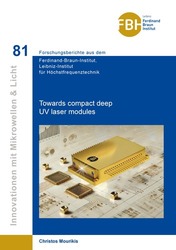| Areas | |
|---|---|
| Serie de libros (96) |
1378
|
| Nachhaltigkeit |
3
|
| Gesundheitswesen |
1
|
| Letra |
2364
|
| Ciencias Naturales |
5406
|
| Matemática | 229 |
| Informática | 319 |
| Física | 980 |
| Química | 1363 |
| Geociencias | 131 |
| Medicina humana | 243 |
| Estomatología | 10 |
| Veterinaria | 108 |
| Farmacia | 147 |
| Biología | 835 |
| Bioquímica, biología molecular, tecnología genética | 121 |
| Biofísica | 25 |
| Nutrición | 45 |
| Agricultura | 1004 |
| Silvicultura | 201 |
| Horticultura | 20 |
| Ecología y conservación de la tierra | 148 |
| Ciencias Ingeniería |
1793
|
| General |
98
|
|
Leitlinien Unfallchirurgie
5. Auflage bestellen |
|
Erweiterte Suche
Towards compact deep UV laser modules (Volumen 81) (Tienda española)
Christos Mourikis (Autor)Previo
Lectura de prueba, PDF (1,7 MB)
Indice, PDF (1,6 MB)
Diode-based laser modules have become a ubiquitous feature in modern society. Their small size, robustness, and low cost make them suitable for a wide range of applications, from hair removal to space exploration. Despite the considerable advancements in diode laser technology across a range of electromagnetic spectra, the use of these devices in the ultraviolet range, particularly at the lower wavelengths, remains relatively constrained. The need for laser devices in the UV spectrum has become increasingly apparent in a variety of significant applications, including those pertaining to biotechnology, sensors, communications, and numerous other major fields. This thesis presents an extended study and development of laser diode-based setups with the main objective: the laser emission in the UVC range and their partial miniaturization of them. The first miniaturized laser module with dimensions of 76 × 43 × 15 mm3 implementing the coherent beam combining concept and capable of generating a maximum optical power of 5 W with a combining efficiency of 85% at 761.1 nm has been implemented. The laser module was utilized as a seed on a second harmonic generation setup with a periodically poled waveguide crystal of stoichiometric LiTaO₃ doped with MgO. The nonlinear crystal exhibited a normalized conversion efficiency of 1.6%/W, resulting in optical powers of up to 18.5 mW at 380.55 nm. UVC emission was achieved by employing a periodically poled bulk LaBGeO5 crystal to generate the sum frequency of the 761.1 and 380.55 nm wavelengths. It successfully generated 5 μW at 253.7 nm resulting a normalized conversion efficiency of 0.03%/W. In addition, potential upgrades to the laser module and further miniaturization of these concepts are discussed and presented.
| ISBN-13 (Impresion) | 9783689528355 |
| ISBN-13 (E-Book) | 9783689528362 |
| Formato | A5 |
| Idioma | Inglés |
| Numero de paginas | 110 |
| Laminacion de la cubierta | mate |
| Edicion | 1. |
| Serie | Innovationen mit Mikrowellen und Licht. Forschungsberichte aus dem Ferdinand-Braun-Institut, Leibniz-Institut für Höchstfrequenztechnik |
| Volumen | 81 |
| Lugar de publicacion | Göttingen |
| Lugar de la disertacion | FH Berlin |
| Fecha de publicacion | 26.03.2025 |
| Clasificacion simple | Tesis doctoral |
| Area |
Ciencias Naturales
Física Ciencias Ingeniería Ingeniería eléctrica general |
| Palabras claves | laser, wavelength, Wellenlänge, semiconductor, Halbleiter, diode, beams, Strahlen, fiber optic telecommunications, faseroptische Telekommunikation, optical drivers, industrial 3D laser welding, airplane wing sensors, optische Treiber, industrielles 3D-Laserschweißen, Flugzeugflügelsensoren, laser diodes, Laserdioden |








